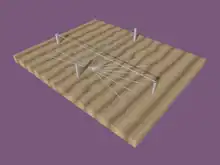
.jpg.webp)
.jpg.webp)
A bifilar dial is a type of sundial invented by the German mathematician Hugo Michnik in 1922. It has two non-touching threads parallel to the dial. Usually the second thread is orthogonal-(perpendicular) to the first. [1] The intersection of the two threads' shadows gives the local apparent time.
When the threads have the correctly calculated separation, the hour-lines on the horizontal surface are uniformly drawn. The angle between successive hour-lines is constant. The hour-lines for successive hours are 15 degrees apart.
History
The bifilar dial was invented in April 1922 by the mathematician and maths teacher, Hugo Michnik, from Beuthen, Upper Silesia. He studied the horizontal dial- starting on a conventional XYZ cartesian framework and building up a general projection which he states was an exceptional case of a Steiner transformation. He related the trace of the sun to conic sections and the angle on the dial-plate to the hour angle and the calculation of local apparent time, using conventional hours and the historic Italian and Babylonian hours. [1] He refers in the paper, to a previous publication on the theory of sundials in 1914.[2]
His method has been applied to vertical near-declinant dials, and a more general declining-reclining dial.
Work has been subsequently done by Dominique Collin.[3]
Horizontal bifilar dial
This was the dial that Hugo Michnik invented and studied. By simplifying the general example so:
- the wires cross orthogonally- one running north-south and the other east-west
- The east west wire passes under the north south dial, so the (latitude)
the shadow is thrown on a dial-plate marked out like a simple equatorial sundial.
The proof
The first wire is orientated north-south at a constant distance from the dial plate
The second wire is orientated east-west at a constant distance from the dial plate (thus is orthogonal to which lies on the plane of the meridian ).
In this proof (pronounced phi) is the latitude of the dial plate.
Respectively, and are the vertical projections of wires and on the dial plate .
Point is the point on the dial plate directly under the two wires' intersection.
That point is the origin of the X,Y co-ordinate system referred to below.
The X-axis is the east–west line passing through the origin. The Y-axis is the north–south line passing through the origin. The positive Y direction is northward.
One can show that if the position of the sun is known and determined by the spherical coordinates et (pronounced t-dot and delta, respectively the known as the hour angle et declination), the co-ordinates and of point , the intersection on the two shadows on the dial-plate have values of :
Eliminating the variable in the two preceding equations, one obtains a new equation defined for and which gives, as a function of the latitude and the solar hour angle solaire , the equation of the trace of the sun associated with the local apparent time. In its simplest form this equation is written:
This relation shows that the hour traces are indeed line segments and the meeting-point of these line segments is the point :
In other words, point C is south of point O (where the wires intersect), by a distance of , where is the latitude.[1]
- Special case
If one arranges the two wire heights and such :
then the equation for the hour lines can be simply written as:
at all times, the intersection of the shadows on the dial plate is such that the angle is equal to the hour angle of the sun so thus represents solar time.
So provided the sundial respects the la condition the trace of the sun corresponds to the hour-angle shown by lines (rays) centred on the point and the 13 rays that correspond to the hours 6:00, 7:00, 8:00, 9:00... 15:00, 16:00, 17:00, 18:00 are regularly spaced at a constant angle of 15°, about point C. [lower-alpha 1][1]
A practical example
A London dial is the name given to dials set for 51° 30' N. A simple London bifilar dial has a dial plate with 13 line segments drawn outward from a centre-point C, with each hour's line drawn 15° clockwise from the previous hour's line. The midday line is aligned towards the north.
The north–south wire is 10 cm () above the midday line. That east-west wire is placed at a height of 7.826 () centimeters- equivalent to 10 cm x sin(51° 30'). This passes through C. The east–west wire crosses the north–south wire 6.275 cm north of the centre-point C- that being the equivalent of - 7.826 () divided by tan (51° 30').
Reclining-declining bifilar sundials
Whether a sundial is a bifilar, or whether it's the familiar flat-dial with a straight style (like the usual horizontal and vertical-declining sundials), making it reclining, vertical-declining, or reclining-declining is exactly the same. The declining or reclining-declining mounting is achieved in exactly the same manner, whether the dial is bifilar, or the usual straight-style flat dial.
For any flat-dial, whether bifilar, or ordinary straight-style, the north celestial pole has a certain altitude, measured from the plane of the dial.
- Effective latitude:If that dial-plane is horizontal, then it's a horizontal dial (bifilar, or straight-style). Then, of course the north celestial pole's altitude, measured from the dial-plane, is the latitude of the location. Well then, if the flat-dial is reclined, declined, or reclined-&-declined, everything is the same as if it the dial were horizontal, with the celestial pole's altitude, measured with respect to the dial-plane, treated as the latitude.
- Dial-North:Likewise, the north celestial pole's longitude, measured with respect to the plane of the dial, with respect to the downward direction (or the direction that a marble would roll, if the dial is reclining) on the dial-face, is the direction that is treated as north, when drawing the hour-lines. I'll call that direction "dial-north".
- Equatorial Longitude (hour-angle) of dial-north:It's necessary to find the equatorial longitude of the dial-north direction (drawn on the dial). In the case of the horizontal dial, of course that's an hour-angle of zero, the south meridian. That determines what time ("dial-north time") is represented by the dial-north line. Other times, before and after that, can then have their lines drawn according to their differences from dial-north time—in the same way as they' be drawn on a horizontal dial-face according to their differences from 12 noon (true solar time).
References
- Footnotes
- Notes
- 1 2 3 4 Michnik 1922.
- ↑ Beiträge zur Theorie der Sonnenuhren, Leipzig, 1914
- ↑ Collin 2000.
- Bibliography
- Michnik, H (1922). "Title: Theorie einer Bifilar-Sonnenuhr" (PDF). Astronomische Nachrichten (in German). 217 (5190): 81–90. Bibcode:1922AN....217...81M. doi:10.1002/asna.19222170602. Retrieved 17 December 2013.
- Collin, Domenique (2000). "Théorie sur le cadran solaire bifilaire vertical déclinant" (in French). F 62000 Calais. Archived from the original on 8 February 2015. Retrieved 8 February 2015.
{{cite journal}}: Cite journal requires|journal=(help)CS1 maint: location (link)

.png.webp)